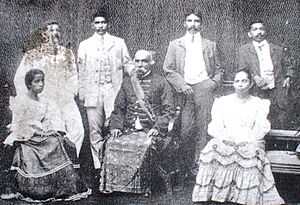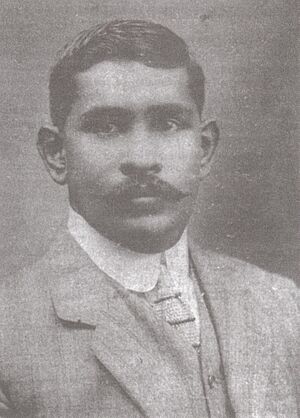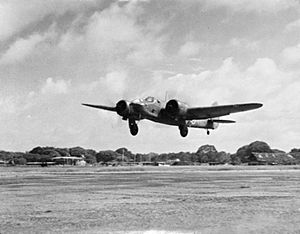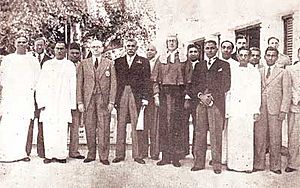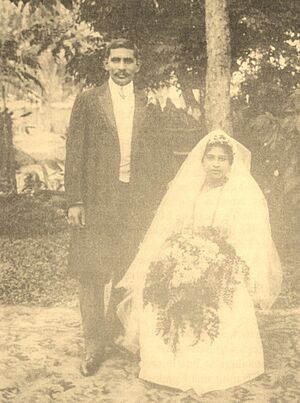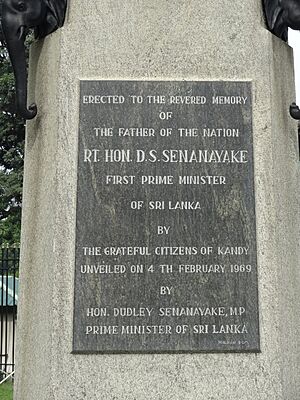D. S. Senanayake facts for kids
Quick facts for kids
Don Stephen Senanayake
|
|
|---|---|
| දොන් ස්ටීවන් සේනානායක | |

Senanayake in 1934
|
|
| 1st Prime Minister of Ceylon | |
| In office 24 September 1947 – 22 March 1952 |
|
| Monarch | George VI Elizabeth II |
| Governor General | Henry Monck-Mason Moore Herwald Ramsbotham, 1st Viscount Soulbury |
| Preceded by | Position established |
| Succeeded by | Dudley Senanayake |
| Leader of the House | |
| In office 2 December 1942 – 4 July 1947 |
|
| Preceded by | Don Baron Jayatilaka |
| Succeeded by | S. W. R. D. Bandaranaike |
| Minister of Agriculture and Lands | |
| In office 1931–1946 |
|
| Preceded by | Post created |
| Succeeded by | Dudley Senanayake |
| Member of the Ceylon Parliament for Mirigama |
|
| In office 14 October 1947 – 22 March 1952 |
|
| Preceded by | Constituency Created |
| Succeeded by | John Amaratunga |
| Personal details | |
| Born | 21 October 1884 Botale, Mirigama, British Ceylon |
| Died | 22 March 1952 (aged 67) Colombo, Dominion of Ceylon |
| Nationality | Ceylonese |
| Political party | United National Party |
| Spouse | Molly Dunuwila |
| Children | Dudley Senanayake Robert Senanayake |
| Parents |
|
| Residence | Woodlands |
| Education | S. Thomas' College, Mount Lavinia |
| Occupation |
|
Don Stephen Senanayake (born October 21, 1884 – died March 22, 1952) was a very important leader from Sri Lanka. He was the first Prime Minister of Ceylon, which is what Sri Lanka was called back then. He led the movement that helped Ceylon become an independent country. Because of his efforts, he is often called the "Father of the Nation".
Don Stephen Senanayake came from a family of successful business owners. He went to S. Thomas' College, Mutwal for his education. After school, he worked briefly in a government office before joining his family's businesses. He and his brothers were involved in a movement that promoted temperance (avoiding alcohol). This movement later grew into the larger fight for independence. During a time of unrest in 1915, the Senanayake brothers were put in prison without any charges. After 46 days, he was released.
In 1924, he was elected to the Legislative Council of Ceylon. Later, in 1931, he became the Minister of Agriculture and Lands in the State Council of Ceylon. He worked hard to improve farming and land use in the country. In 1947, he was elected to the first Parliament of Ceylon. He then formed the government and became Ceylon's first Prime Minister. He served in this role until he passed away in 1952.
Contents
Early Life and Education
Don Stephen Senanayake was born on October 21, 1884. His family lived in a village called Botale, which is now part of Mirigama. His father, Don Spater Senanayake, was a wealthy businessman. He made money from mining graphite and from plantations. His mother was Dona Catherina Elizabeth Perera Gunasekera Senanayake.
Stephen had two older brothers, D. C. Senanayake and F. R. Senanayake. He also had a sister, Maria Frances. His family was Buddhist. He went to S. Thomas' College, Mutwal, which was an Anglican school. He wasn't the best student in academics. However, he was very good at sports, especially cricket. He even played in famous school matches.
Early Career and Business
After finishing school, Don Stephen Senanayake worked for a short time in a government department. But he soon left to join his older brother, D. C. Senanayake, in managing their family's businesses.
He became a planter and helped introduce rubber as a new crop on their family farms. He also managed the Kahatagaha Graphite Mine. This mine was owned by his brother F. R. Senanayake's wife's family. In 1914, he was chosen to be part of a government group. This group traveled to Madagascar to learn about their graphite mining industry.
Starting His Political Journey
Early Activism for Change
The three Senanayake brothers were active in the temperance movement. This movement started in 1912. When World War I began in 1914, they joined a local defense group called the Colombo Town Guard.
During the riots of 1915, the brothers were arrested and put in prison. They were held without any charges. The British Governor at the time thought the temperance movement was causing trouble. Don Stephen was released after 46 days in prison. The harsh way the British handled these riots made many people want independence. Don Stephen and his brothers became important leaders in the movement to free Ceylon from British rule.
Joining the Legislative Council
In 1924, Senanayake was elected to the Legislative Council of Ceylon. He was the only candidate, so he won without anyone running against him. He became the Secretary for the non-government members of the Council. He was very interested in topics like farming, land, and irrigation.
He spoke up in the Council about unfair policies. He also questioned the high costs of railway lines and delays in building a dam. He strongly supported creating the first university in Ceylon near Kandy. When his brother F.R. passed away in 1925, Don Stephen took over his role as a leader in the independence movement.
Becoming a State Council Minister
In 1931, he was elected to the new State Council of Ceylon. He represented the Ceylon National Congress. At the first meeting of the State Council, he was chosen to be the Minister of Agriculture and Lands. He led the committee that focused on these areas.
Improving Agriculture and Land
As Minister, he worked hard to solve Ceylon's farming problems. He created the Land Development Ordinance, a new law to manage land. He also introduced policies to help Ceylon grow enough rice for its people. His work earned him a lot of respect. He continued to be a minister for fifteen years, being re-elected in 1936.
He also started a program to modernize farming. He helped expand the co-operative movement and played a part in starting the Bank of Ceylon. In 1938, he introduced a law to protect plants and animals. This led to the creation of the Yala National Park.
Role During World War II
When World War II reached Asia, Don Stephen Senanayake became very involved in managing food supplies. He was also in charge of many defense projects. One important task was quickly building an airfield at the Colombo Racecourse. He completed this, which helped protect Ceylon during an air raid.
During this time, he worked closely with Dr. Ivor Jennings. Dr. Jennings was an expert on how governments are set up. He became Senanayake's advisor on making changes to the constitution. These changes were important for Ceylon to gain independence.
Leading the Way to Independence
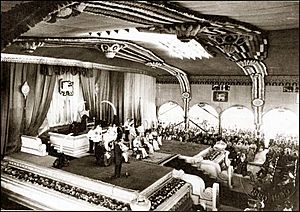
In 1942, Senanayake became the Leader of the House in the State Council. In 1943, the British Government said that Ceylon's ministers could suggest changes to their constitution. Senanayake left the National Congress because he disagreed with their ideas about independence. Instead, he presented his own plan for Ceylon to become a self-governing nation within the British Commonwealth. His ideas were accepted.
In 1946, he resigned from his ministry to push even harder for full independence. That same year, he created the United National Party (UNP). This party brought together several groups that wanted Ceylon to be a self-governing nation.
When India gained independence in 1947, it opened a new chance for Senanayake. He used the new constitution suggested by the Soulbury Commission to argue for Ceylon's freedom. The British government agreed to his proposals for self-rule. Senanayake then presented this new constitution to the State Council, and it was approved.
Elections were held in 1947. Senanayake won his seat easily. His party, the UNP, didn't win a majority of seats on its own. However, they formed a government by working with another party, the All Ceylon Tamil Congress.
On September 24, 1947, he was asked to form Ceylon's first government. He became the first Prime Minister. On February 4, 1948, Ceylon officially became an independent nation. This was a huge moment for the country.
First Prime Minister of Ceylon
As Prime Minister, Senanayake started building the necessary parts of an independent country. Even though Ceylon had its own government, it still relied on Britain for trade, defense, and foreign affairs. He chose not to accept a knighthood. However, he kept good relationships with Britain. In 1950, he became the first Ceylonese person to join the Privy Council.
Developing the Nation
He had big plans to spread out the population. His Gal Oya project moved over 250,000 people to new areas. He continued the farming policies he started as Minister of Agriculture. His son, Dudley Senanayake, now held that position. With a growing population and food shortages from the war, Senanayake wanted Ceylon to grow its own food. Important historical sites in Anuradhapura and Polonnaruwa were also restored during this time. He also suggested expanding hydro-electric power in Ceylon.
Citizenship Laws
Senanayake's government introduced the Ceylon Citizenship Act in 1948. This law made it difficult for many people of Indian origin living in Ceylon to become citizens. More than 700,000 people, about 11% of the population, were left without citizenship. This law was strongly opposed by groups representing Indian Tamils and Sri Lankan Tamils.
Foreign Relations
Senanayake was also in charge of foreign affairs and defense. He developed Ceylon's foreign policy after independence. He built relationships with other countries. Ceylon joined the Commonwealth and established diplomatic ties with countries like the United States and Japan. He also created the Ceylon Overseas Service to train diplomats. In 1950, he hosted a meeting of Commonwealth Foreign Ministers in Colombo. This meeting led to the creation of the Colombo Plan, which helped with development in Asian countries.
Building the Military
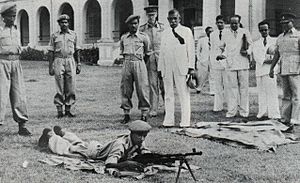
Before independence, Ceylon had a small volunteer defense force. Senanayake introduced new laws to create the Armed Forces of Ceylon. These included the Army Act (1949), Navy Act (1950), and Air Force Act (1951). He kept British military bases in Ceylon and got their help to train and equip the new Ceylonese military.
Political Challenges
In his early years as Prime Minister, Senanayake faced some opposition. He also had disagreements with S. W. R. D. Bandaranaike, a powerful member of his cabinet. Bandaranaike had joined Senanayake's party, thinking he would become the next leader. However, Senanayake showed no signs of retiring. In 1951, Bandaranaike resigned from his positions and formed his own party, the Sri Lanka Freedom Party (SLFP). Senanayake then took over Bandaranaike's old roles and worked to counter his new party in parliament.
Death and Legacy
On the morning of March 21, 1952, Senanayake was riding his horse, Chitra, on Galle Face Green. He often took rides there. Suddenly, he fell off his horse. He was taken to a nursing home and remained unconscious for over a day. Doctors believed he had a stroke. He passed away at 3:30 pm on March 22, 1952.
His body was taken to his official residence, Temple Trees. Then it was moved to the House of Representatives for people to pay their respects. Over half a million people came to see him. His state funeral was attended by more than 32,000 people. The procession ended at Independence Square, where his body was cremated according to Buddhist traditions.
Personal Life
D. S. Senanayake loved animals. He had many pets, including elephants, horses, and cattle. He was also a keen gardener and grew orchids. He often wore an orchid on his suit. He had diabetes for much of his later life.
He married Molly Dunuwila in 1910. They had two sons, Dudley Senanayake and Robert Senanayake. His oldest son, Dudley, became Prime Minister after him in 1952. Later, his nephew, Sir John Kotelawala, also became Prime Minister. His family continued to be important in Sri Lankan politics for many years.
His Lasting Impact
D. S. Senanayake is highly respected by many people in Sri Lanka, especially the Sinhalese and some Muslims. However, some Tamils were unhappy with his citizenship laws. These laws made many Tamils of Indian origin lose their citizenship.
Despite some criticisms, his strong agricultural plans and his focus on modernizing the country were important. Under his family's leadership, Sri Lanka's economy grew. He is still remembered as "The Father of Sri Lanka" for leading the country to independence.
Many statues of D. S. Senanayake have been built across the island. One is at the Independence Memorial Hall in Colombo. The large lake created by the Gal Oya Dam is named the Senanayake Samudraya in his honor. Many schools and public buildings are also named after him. A special shield is awarded at the Royal–Thomian cricket match, which he played in during his school days.
Titles and Honours
- Mr Don Stephen Senanayake MLC (1924–1931)
- Mr Don Stephen Senanayake (1931–1947)
- Hon Don Stephen Senanayake MP (1947–1950)
- The Rt Hon Don Stephen Senanayake MP (1950–1952)
Appointments
- Privy Councillor (1950)
Educational Honours
 LLD (honorary) - University of Ceylon - 1949
LLD (honorary) - University of Ceylon - 1949
Electoral History
| Election | Constituency | Party | Votes | Result | |
|---|---|---|---|---|---|
| 1924 legislative council | Negombo | Independent | Uncontested | Elected | |
| 1931 state council | Negombo | Independent | Elected | ||
| 1936 state council | Negombo | Independent | Elected | ||
| 1947 parliamentary | Mirigama | United National Party | 26,762 | Elected | |
See also
- List of political families in Sri Lanka
- Nidahase Piya DS, a biographical film based on DS's life


